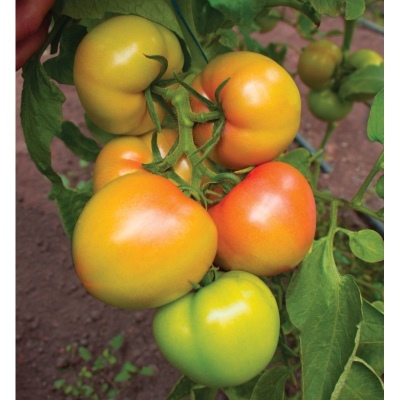
- Authors: Kitano Seeds
- Name synonyms: Kibo
- Category: hybrid
- Growth type: indeterminate
- Appointment: fresh consumption
- Ripening period: early
- Ripening time, days: 100-110
- Growing conditions: for open ground, for film greenhouses
- Marketability: high
- Transportability: Yes
Every gardener dreams of collecting delicious tomatoes during the summer and autumn. This is possible if you select the correct and productive types of tomatoes for planting on the site. One of these is considered by many to be the favorite hybrid variety of Kibo, which is grown both in the beds and in greenhouses.
Breeding history
The early ripe Kibo tomato of Japanese origin is the result of many years of work by the breeders of Kitano Seeds. Despite the demand for the species among gardeners and farmers of our country, the variety is not included in the State Register of the Russian Federation today, therefore the growing regions have not been precisely established. The task of the scientists was to create a nightshade crop grown in a greenhouse. If the greenhouse is heated, then the tomato is able to bear fruit all year round.
Description of the variety
Tomato Kibo is an indeterminate tall shrub that stretches up to 200 cm in height. The plant is characterized by compactness, moderate thickening, dark green foliage with roughness, developed root system, powerful stems that form a large number of flower brushes. Up to 5-6 ovaries can form on one brush. The tallness of the bush requires the installation of supports and a garter. In addition, the plant requires regular pinching.
The main qualities of the fruit
The Kibo tomato represents a class of large-fruited crops. On average, the mass of a tomato reaches 320-350 grams. Among the characteristic features of the fruit, it is worth highlighting a uniform pink color, a flat-round shape, an ideally dense skin with a glossy coating, which protects it from cracking. The density of the peel provides good transportability of fruits and long shelf life (up to 2-3 months, subject to storage conditions, if harvested in an unripe form).
Taste characteristics
The taste is of a high level. The Kibo tomato is endowed with fragrant pulp without a white center and a huge number of seeds. In addition, the pulp is very juicy, but without wateriness. The dry matter content of tomatoes is about 7%. The taste is dominated by sweetness and sugariness. The tomato contains many useful components and vitamins. The optimal balance of pulp and juiciness allows you to use the vegetable both fresh, and canned, and processed (dressings, sauces, juices, purees).
Ripening and fruiting
Kibo is an early ripening tomato variety. From the emergence of seedlings to the ripening of the first berries, 100-110 days pass. Mass fruiting of bushes begins 2 weeks after the formation of the first ripe berry. The fruiting period is somewhat extended, which allows you to enjoy fresh and tasty tomatoes for a long time.
Yield
This variety is high-yielding. Subject to the basic rules of agricultural technology, it is possible to harvest up to 10-14 kg of fruits per season from one bush, which is several times more than in other types of determinant tomatoes.
The timing of planting seedlings and planting in the ground
Sowing seeds for planting is carried out in mid-February. Seedlings grow in 55-65 days. The greenhouse effect will help speed up the emergence of seedlings. At the stage of appearance of 2-3 leaves on the bush, a dive (seating) is carried out. Growing seedlings is carried out in a well-lit place. It is recommended to harden the plants 10-15 days before planting in a permanent place of growth.
Planting plants in a greenhouse (open ground is allowed only in the southern regions) can be performed at the stage when the bush has 8-12 true leaves.

Growing tomato seedlings is an extremely important process, because it largely depends on whether the gardener will be able to harvest at all. All aspects must be taken into account, from seedbed preparation to planting in the ground.
Landing scheme
For healthy growth and easy maintenance, no more than 3 bushes of seedlings should be planted per 1 m2. The optimal distance between the bushes is 60 cm.

Growing and care
The ideal soil for growing tomatoes is the one on which legumes, cucumbers or onions were previously grown. The soil must be disinfected. Remove weeds. Loosen, which improves air permeability, moisturize and apply top dressing.
Agrotechnics for healthy growth and development of culture include: moderate watering, fertilizing (phosphorus and potash fertilizers), pinching and tying bushes, as well as airing (if tomatoes grow in a greenhouse).




A plant needs different micronutrients at each stage of growth. All fertilizers can be divided into two groups: mineral and organic. Folk remedies are often used: iodine, yeast, bird droppings, eggshells.
It is important to observe the rate and period of feeding. This also applies to folk remedies and organic fertilizers.
Disease and pest resistance
High immunity protects the plant from many viruses and diseases. Preventive treatment with special preparations containing sulfur and copper will help prevent diseases.


Resistant to adverse weather conditions
The culture is resistant to sharp temperature fluctuations, prolonged heat and drought. The variety is stress-resistant, therefore, weather disasters do not affect the yield.
Growing regions
Due to the fact that the variety is more prone to growing in greenhouse conditions, it can be grown in all regions of the Russian Federation.
Review overview
Based on the numerous reviews of summer residents and farmers, a number of conclusions can be drawn. The Kibo variety is unpretentious, quickly adapts to conditions, gives high and stable yields that can keep their presentation for a long time.

























































































